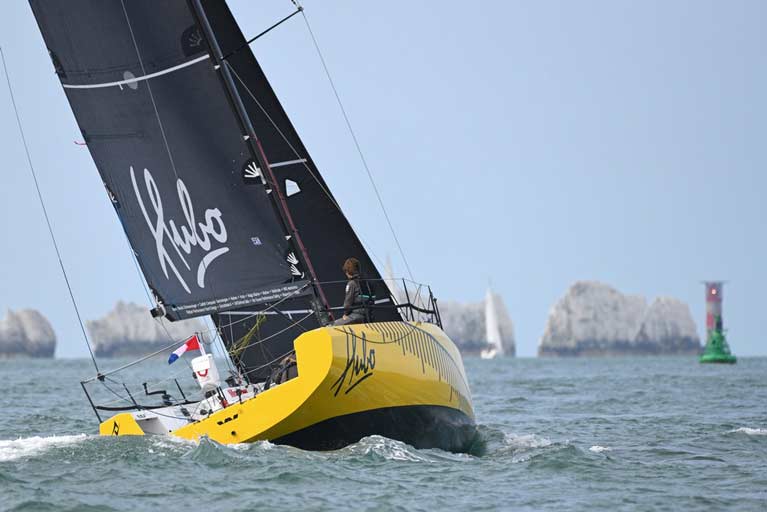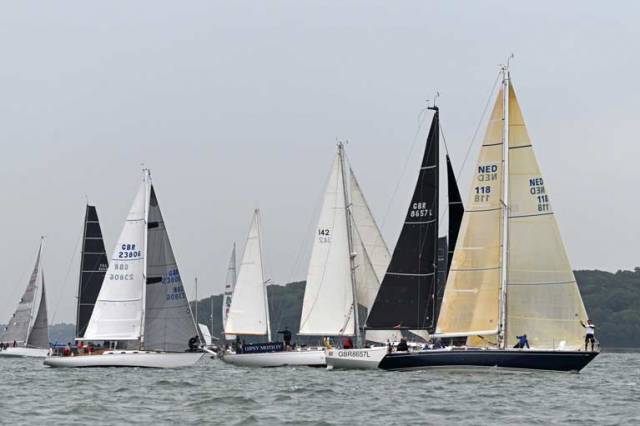"Twist" is one of the many buzzwords in sailing. We might know what it is and when it's needed – and when it’s not – but why do we need twist in the first place? And what effects does it have in our decision making process all around the race course? Graham Curran of UK Sailmakers Ireland takes us through his thoughts on sail twist.
Walking through Dublin Airport arrivals, fresh off the plane from Southampton after the weekends’ RORC Channel Race, I was going through the events of the previous day and night. I was sailing aboard Chris Frost’s Swan 36 “Finola” in preparation for our Fastnet Race starting next weekend.
We crossed the line at 0800 on Sunday morning after 23 hours of racing – finishing 2nd in our class about four minutes behind the winner. As is usually the chase when you finish second; I was going through the race in my head to find where we could have gained those four minutes of corrected time. There were several occasions where there were gains to be had or losses that could have been avoided, but there is one in particular which we found interesting – and which leads into the topic of this article.
Critical Sail Selection
At 0200 on Sunday morning we were in the last 40 mile stretch of our course – approaching the Owers turning mark before heading back for the Solent. We had been flying our S2 spinnaker (symmetric runner) since the start of this long downwind leg in 12-15 knots of breeze. As we rounded St Catherine’s point and made our way to Owers the breeze began to steadily clock right; making our sailing angle tighter and tighter.
Eventually, we ended up tight reaching with our pole just off the forestay with our log reading around 6.8 – 7.5 knots with a significant load on the helm and lots of active mainsheet trimming needed to keep the boat on her feet. Something needed to change. Finola’s set up left us with three options – continue as we were, unfurl our 145% overlapping genoa and set up on an outboard lead, or swap to our Code Zero. There were several things to consider when making this decision including the late hour, the breeze, sail sizes, effective ranges etc.
"Something needed to change"
Our decision was to drop the spinnaker and unfurl our genoa and set up an outboard lead for effective sheeting, and then consider launching our Code Zero after evaluating the situation. As always the lads on the bow played a blinder; the drop and swap was done seamlessly without issue. We gave ourselves ten minutes to settle and evaluate and found the boat was much easier to handle with little or no undue pressure on the helm, but our speed was down to 6.0 knots – time to try the Code Zero. After a short period of bow work and cockpit setup we had the Code Zero flying and our genoa furled up once again. Settle and evaluate. Finola was now cruising along at 6.8 to 7.5 knots once again, as we were with our S2 spinnaker up, but the difference in her behaviour was dramatic. No significant heel and a wonderfully balanced helm. A valuable lesson learned (several lessons in fact) – but what does all this have to do with twist you ask? Let me explain.
What is Twist?
Twist in its raw form is a difference in your sails’ angle of incidence when measured at points of increasing height up your sail. Simply put; it is the amount the sail “twists open” at the top when compared to the lower sections.
"We increase twist in light winds, we take it out as the wind increases"
Most of us think of twist in the context of sailing upwind with a mainsail and jib/genoa. We increase twist in light winds, we take it out as the wind increases. This has a lot to do with how the wind is behaving at different heights. Wind that is closer to the surface is slowed due to friction and, as a result, its angle is changed. Wind which is higher (farther from the surface) does not experience the same amount of friction, so its angle is not changed as much. As such we have varying wind angles at increasing heights so we, in turn, need to twist our sails to make sure our sail is trimmed correctly to the changing wind angles at the different heights. This is particularly important at low wind speeds where the wind angle difference is significant. As the wind speed increases the surface friction has less of an effect on the wind angle – there ends up being little difference in angle between the top and bottom of your mast (depending on your mast height of course) – so less twist is needed to trim your sail correctly.
The above applies to sailing upwind – and we are familiar with it as a sail trim fundamental – but there is another more intrinsic way of looking at twist which applies to all modes of sailing. In essence twist gives us the ability to control the lift and drag produced by our sails.
 W36 “Hubo” on her way out of the Solent. Hubo went on to win the IRC Two-Handed Division and IRC Class 3 overall Photo: RORC/Rick Tomlinson
W36 “Hubo” on her way out of the Solent. Hubo went on to win the IRC Two-Handed Division and IRC Class 3 overall Photo: RORC/Rick Tomlinson
The Lift and Drag Compromise
Life is all about compromise. Sailing is no different. Where there is lift, there is drag. Our goal as sailors is to maximise and harness lift while minimizing resulting drag. Lift gives us the power to move forward, above and below the water. Drag is what slows us down, usually manifesting itself as heel and stall.
So lift and drag are intrinsically linked – they go hand in hand. In some cases drag is a good thing. There is a tipping point where having a relatively high amount of drag is good as its corresponding lift is more beneficial to the entire sail plan. But for the vast majority of our sailing drag is bad, lift is good.
So how does this tie in with Sunday morning’s lesson aboard Finola?
Drag Bad, Lift Good
Let’s keep it simple, primal as it were – down to caveman style “drag bad … lift good”. When we were reaching with our S2 spinnaker we had plenty of lift. The boat was moving through the water at hull speed or above it. We had all the lift we needed. The problem was that the spinnaker was causing too much drag, which manifested itself as heeling moment. To keep the boat on her toes we need to use a lot of rudder and ease the mainsheet. More rudder means more drag below the waterline – slowing the boat as a result. All of this making the crew work much harder than is needed at 2am in the morning.
This is not the spinnaker’s fault. A running spinnaker will simply, by design, not reach effectively. It has a deep profile with wide shoulders. Great for running downwind. Not so great when sheeted in hard while reaching. The shoulders close in behind the mainsail, hook, and stall, causing drag and heeling the boat.
So we opt for the genoa instead of instead – dramatically less drag as the sail can be trimmed perfectly for the angle of sailing with the ability to get the twist correct without causing any hook (drag) in the leech – but the sail did not produce enough lift to keep us at the speeds we were doing with the spinnaker. This is mainly due to the drop in sail area, the genoa; even at 145% overlap, is less than half the size of the spinnaker. So on the whole it was more effective having the spinnaker up, despite its drag downsides.
Enter the Code Zero. At 58sqm it splits the difference in size between the spinnaker and genoa but, far more crucially, it is designed with much more twist in the leech. When we trimmed our Code Zero on the log instantly jumped back to the 7ish knots we were looking for – but without the excessive heel we had with the spinnaker. A Code Zero is designed to sail with a lot more twist in its leech when compares to a running spinnaker. Although the Code Zero will produce less lift, mostly because it has a smaller sail area, it will also produce less drag than a hooked stalling spinnaker. The Code Zero produces more net lift, despite its smaller size, and it all comes down to what? – twist.
 Code Zeros set at the start of the RORC Channel Race 2019 Photo: RORC/Rick Tomlinson
Code Zeros set at the start of the RORC Channel Race 2019 Photo: RORC/Rick Tomlinson
Conclusion(s) about twist
To be very clear, this is not a pump piece for Code Zeros. They are great sails and they have their place, and are much more versatile than they are given credit for, but that is not the point here.
We used twist to reduce drag and increase lift. We did it in the form of a sail change. But this is not always the case. Next time you’re sailing and you’re fighting the helm, or your boat speed is slow and you don’t know why, or you need to accelerate to avoid being rolled – consider the lift and drag relationship and use twist to tip the balance in your favour.
Before I sign off I want to share two more quick notes on this particular situation.
Firstly – we used the Channel Race explicitly for the purposes of learning ahead of the Fastnet. I would certainly consider not swapping to the Code Zero straight away as a mistake in the context of the Channel Race alone. It may not have cost us the four minutes needed to win but it certainly contributed. But in reality – that is exactly what we were there to do – that was the time to be conservative and learn the lesson. The minute or so of lost time during the 2019 Channel Race could potentially yield many more minutes of time gained in next week’s Fastnet Race as we now has a very clear understanding of where and when the Code Zero becomes effective in our inventory. These lessons need to be learned some time – best to do it before the big one rather than during it! As always – time on the water is key!
Secondly and finally – a note on sail area. It is not the be-all and end-all, as we’ve just proven. Bigger is not always better. Design and effective application are far more important. So next time you think “throw up the biggest one we have!” stop and consider the situation – you may just find the net gain elsewhere.



























































